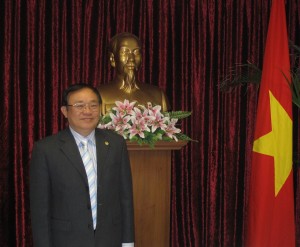 ASTANA, Nov. 15 – Vietnam and Kazakhstan have major untapped potential for developing bilateral commercial ties and recent moves and trends suggest these ties will strengthen over the next few months and years, Hanoi’s ambassador in Astana said.
ASTANA, Nov. 15 – Vietnam and Kazakhstan have major untapped potential for developing bilateral commercial ties and recent moves and trends suggest these ties will strengthen over the next few months and years, Hanoi’s ambassador in Astana said.
Ambassador of Vietnam to Kazakhstan Nguyen Van Hoa welcomed the Nov. 11 decree by President Nursultan Nazarbayev establishing a Kazakhstan embassy in Hanoi and told The Astana Times that it would lead to widening opportunities for economic ties.
“Our relations have just recently begun,” said the ambassador. While the two countries established diplomatic relations in 1992, Vietnam only established an embassy in Astana in 2008.
Ambassador Nguyen started his diplomatic mission in Astana in June2012 and has already overseen a successful visit to Kazakhstan by Vietnamese President Trương Tấn Sang. He expects ties to develop dynamically in the future.
Despite being in the early stages of their relationship, the two countries, which are separated only by China but by a distance of nearly 5,500 kilometres, saw trade reach US$150 million in the first nine months of this year, the ambassador reported. Trade is heavily slanted towards Vietnamese exports to Kazakhstan, consisting mostly of computers and electronics.
“Kazakhstan is ranked fourth among our trading partners in the CIS countries, with Russia being the largest trading partner, Ukraine the second and Belarus third,” he said.
“Everything depends on transportation: it has to be convenient. Vietnam has been actively discussing signing a Free Trade Agreement (FTA) with the Customs Union, so things are going to be better,” Nguyen asserted.
The FTA between the Customs Union and Vietnam may be signed as early as 2014-15, Hanoi’s ambassador said. Two-way trade between Vietnam and the Customs Union of Russia, Belarus and Kazakhstan stood at US$2.7 billion in 2012 alone and the agreement is expected to help the two sides achieve their goal of raising bilateral trade turnover to US$10 billion before 2020. It will also contribute to boosting political, economic, trade and investment relations between the four countries.
According to Kazakhstan’s customs statistics, bilateral trade between Kazakhstan and Vietnam in 2010 amounted to US$38.2 million (exports: US$10.8 million; imports: US$27.4 million). In 2011, this number increased to US$59.1 million (exports: US$7.3 million; imports: US$51.8 million) and in 2012, it reached US$106.2 million (exports: US$5.07 million; imports: US$101.13 million). The main Kazakh exports are construction materials, iron, metal, asbestos and other materials, while Vietnam mostly exports tea, medicine, electronics, cosmetics, shoes, and computer hardware to Kazakhstan.
To promote ties, the two countries also maintain a dialog platform in the shape of a Kazakhstan-Vietnam intergovernmental commission on trade, economic, scientific and technical cooperation. Its sixth meeting took place on Nov. 12 in Hanoi, co-chaired by Deputy Foreign Minister Kairat Sarybai and Deputy Minister of Industry and Trade Le Duong Quang. Officials focused on cooperation areas such as customs, agriculture, education, healthcare, culture, tourism and sport. Noting the 2.4-times expansion in mutual trade this year so far compared to the previous year, officials agreed to further expand the list of agreements setting conditions for economic ties and to establish a working group on interaction among banks.
Vietnam, like Kazakhstan, pursues a multi-vector foreign policy, Ambassador Nguyen explained in an interview. He emphasised, though, that top priority is given to countries within the ASEAN community, followed by major powers like China, the United States and Russia. Then come “our traditional friends like Kazakhstan and other former republics of the USSR.” The European Union is currently Vietnam’s largest trading partner, followed by the United States.
One of the biggest partnerships between Kazakhstan and Vietnam is the collaboration of KazMunayGas and PetroVietnam that started in 2009. Since that time, the companies’ working groups have had four meetings and worked to continue developing work experience and trade.
Vietnam also participated in EXPO 2010 in Shanghai. “We don’t have a clear plan for EXPO 2017 in Kazakhstan yet, but we hope our experience will help here. Kazakhstan provides us with good conditions to participate,” the ambassador said, “and of course we will exhibit our national companies.”
The ambassador noted that hospitality and openness are shared traits of both the Kazakh and Vietnamese cultures. “I feel at home here [in Kazakhstan], because we already knew a lot about this country,” the ambassador, who visited the former Soviet Union in the past for studies and exchanges, said.
Like most other foreigners coming from warm, tropical climates, though, he said that Astana’s colds and gusty winds are some of the biggest challenges he faces during his stay.
There are only a few dozen Vietnamese in Kazakhstan, most of them in Almaty and only three in Astana.
“They used to live in Russia; now they’ve moved to Kazakhstan. They live here and it is good. We really hope we see many more citizens from Vietnam here,” Nguyen said.
More Kazakhs will certainly be travelling to Vietnam with the advent of a direct Almaty-Ho Chi Minh City flight in January 2013. The country’s top diplomat in Astana believes the number of visitors coming both for business and recreation at some of Vietnam’s most popular resorts in and near Nha Trang is set to double if not triple in the near future.


